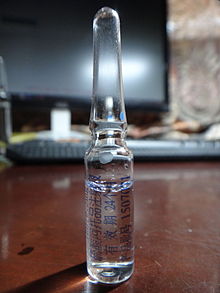Dosage form
Dosage forms(also calledunit doses) arepharmaceutical drugproducts presented in a specific form for use. They contain a mixture ofactive ingredientsand inactive components (excipients), configured in a particular way (such as acapsuleshell) and apportioned into a specificdose.For example, two products may both beamoxicillin,but one may come in 500 mg capsules, while another may be in 250 mg chewable tablets.
The termunit dosecan also refer to non-reusable packaging, particularly when each drug product is individually packaged.[1]However, the FDA differentiates this by referring to it asunit-dose "packaging" or "dispensing".[2]Depending on the context,multi(ple) unit dosemay refer to multiple distinct drug productspackagedtogether or asingleproduct containing multiple drugs and/or doses.
Formulations
[edit]The termdosage formmay also sometimes refer only to thepharmaceutical formulationof a drug product's constituent substances, without considering its final configuration as a consumable product (e.g., capsule, patch, etc.). Due to the somewhat ambiguous nature and overlap of these terms within the pharmaceutical industry, caution is advisable when discussing them with others who may interpret the terminology differently.
Types
[edit]Dosage forms vary depending on the method/route of administration, which can include many types of liquid, solid, and semisolid forms. Common dosage forms includepills,tablets,capsules,drinks,andsyrups,among others.
Acombination drug(or fixed-dose combination; FDC) is a product that contains more than oneactive ingredient(e.g., one tablet, one capsule, or one syrup with multiple drugs).
Innaturopathy,dosages can take the form ofdecoctionsandherbal teas,in addition to the more conventional methods mentioned above.
Route of administration
[edit]Theroute of administration(ROA) fordrug deliverydepends on the dosage form of thesubstance.Different dosage forms may be available for a particular drug, especially if certain conditions restrict the ROA. For example, if a patient is unconscious or experiencing persistentnauseaandvomiting,oral administration may not be feasible, necessitating the use of alternative routes, such asinhalational,buccal,sublingual,nasal,suppository,orparenteral.
A specific dosage form may also be required due to issues such aschemical stabilityorpharmacokineticproperties. For instance,insulincannot be given orally because it is extensivelymetabolizedin thegastrointestinal tract(GIT) before it reaches thebloodstream,preventing it from reaching therapeutic target destinations. Similarly, the oral and intravenous doses of a drug likeparacetamoldiffer for the same reason.[3]
Oral
[edit]

- Pills,i.e. tablets or capsules
- Liquids such as syrups, solutions,elixers,emulsions,andtinctures
- Liquids such as decoctions and herbal teas
- Orally disintegrating tablets
- Lozengesor candy (electuaries)
- Thin films(e.g.,Listerine Pocketpaks,nitroglycerin) to be placed on top of or underneath the tongue as well as against the cheek
- Powdersoreffervescent powder or tablets,often instructed to be mixed into a food item
- Plants or seeds prepared in various ways such as acannabis edible
- Pastes such as high fluoridetoothpastes
- Gases such asoxygen(can also be delivered through the nose)
Ophthalmic
[edit]
Inhalation
[edit]- Aerosolizedmedication
- Dry-powder Inhalersormetered dose inhalers
- Nebulizer-administered medication
- Smoking
- Vaporizer-administered medication
Unintended ingredients
[edit]Talc is anexcipientoften used in pharmaceutical tablets that may end up being crushed to a powder against medical advice or for recreational use. Also,illicit drugsthat occur as white powder in their pure form are oftencutwith cheaptalc.Natural talc is cheap but containsasbestoswhile asbestos-free talc is more expensive. Inhaled talc that has asbestos is generally accepted as being able to cause lung cancer if it is inhaled. The evidence about asbestos-free talc is less clear, according to theAmerican Cancer Society.[4]
Injection
[edit]
Parenteral
[edit]- Intradermally-administered (ID)
- Subcutaneously-administered (SC)
- Intramuscularly-administered (IM)
- Intraosseousadministration (IO)
- Intraperitoneally-administered (IP)
- intravenously-administered (IV)
- Intracavernously-administered (ICI)
These are usually solutions and suspensions.
Unintended ingredients
[edit]Safe
[edit]Eye drops(normal saline in disposable packages) are distributed to syringe users byneedle exchange programs.[citation needed]
Unsafe
[edit]The injection of talc from crushed pills has been associated withpulmonary talcosisin intravenous drug users.[5]
Topical
[edit]- Creams,liniments,balms (such as lip balm or antiperspirants and deodorants), lotions, or ointments, etc.
- Gelsandhydrogels
- Ear drops
- Transdermalanddermal patchesto be applied to the skin
- Powders
Unintended use
[edit]- It is not safe to calculate divided doses by cutting and weighing medical skin patches, because there's no guarantee that the substance is evenly distributed on the patch surface.[6]For example,fentanyltransdermal patches are designed to slowly release the substance over 3 days. It is well known that cut fentanyl transdermal consumed orally have cause overdoses and deaths.
- Singleblotting papersfor illicit drugs injected from solvents in syringes may also cause uneven distribution across the surface.
Other
[edit]- Intravaginal administration
- Vaginal rings
- Capsules and tablets
- Suppositories
- Rectal administration(enteral)
- Suppositories
- Suspensions and solutions in the form ofenemas
- Gels
- Urethral
- Nasal sprays
See also
[edit]- Classification of Pharmaco-Therapeutic Referrals
- Drug delivery
- Route of administration
- Pharmaceutical packaging
References
[edit]- ^"unit dose".thefreedictionary.
- ^Affairs, Office of Regulatory."Compliance Policy Guides - CPG Sec 430.100 Unit Dose Labeling for Solid and Liquid Oral Dosage Forms".fda.gov.
- ^"Doctors 'missed' fatal overdoses".4 February 2011 – via bbc.co.uk.
- ^"Talcum Powder and Cancer".cancer.org.
- ^Davis, LL. (Dec 1983)."Pulmonary" mainline "granulomatosis: talcosis secondary to intravenous heroin abuse with characteristic x-ray findings of asbestosis".J Natl Med Assoc.75(12): 1225–8.PMC2561715.PMID6655726.
- ^Cohen, Michael R. (1 March 2013)."The danger with cutting medication patches: Institute for Safe Medication Practices".Pharmacy Today.19(3): 88.doi:10.1016/S1042-0991(15)31507-3.ISSN1042-0991.Retrieved17 May2022.
External links
[edit] Media related toDosage formsat Wikimedia Commons
Media related toDosage formsat Wikimedia Commons- Dosage From Development






